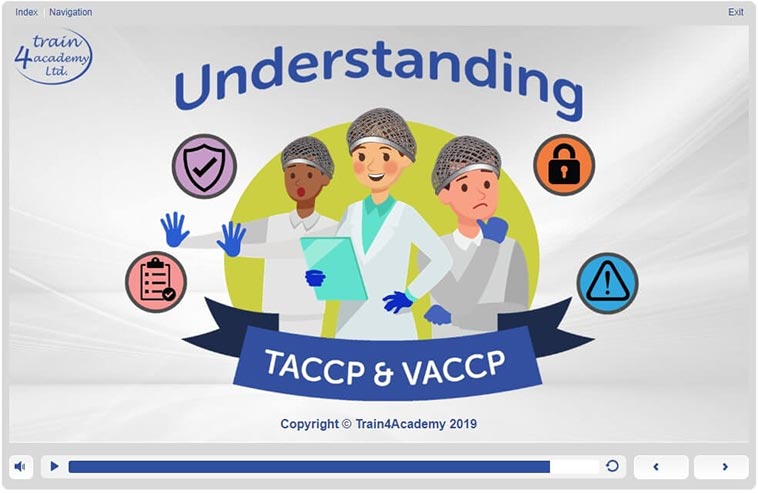TACCP and VACCP Training - Why We Need Them
05/11/2019
Find out more about VACCP and TACCP acronyms and why training will be required.
TACCP stands for Threat Assessment, and Critical Control Points and VACCP is Vulnerability Assessment and Critical Control Points, which are new food safety programs, based on the better-known term HACCP (Hazard Analysis Critical Control Point).
HACCP is familiar to all food companies, as a systematic approach to food safety that is designed to prevent or minimise the risk of unintentional contamination of food. It is not designed for, nor is it effective in, addressing intentional acts of contamination. There are significant food safety and food quality concerns that are outside the purpose of HACCP. TACCP and VACCP have been developed to address intentional acts of contamination, threats and vulnerability to the food supply chain and the food business.
Just as HACCP is a systematic assessment of food safety hazards that might threaten the production of safe food, TACCP is a systematic assessment of the threats to the business from attack, fraud and other malicious actions. VACCP employs a systematic approach to evaluate the vulnerabilities (susceptibility to food fraud risk) that may be present in a food business.
These acronyms are becoming more familiar with the food industry due to the rise in intentional tampering of food. Both approaches are complementary and can be assessed and managed under a single threat and vulnerability management system.

Definitions - What are Threats and Vulnerabilities?
In terms of food production, a threat is defined as:
a statement of intention to inflict pain, injury, damage or other hostile action on someone.
It is a deliberate act by an individual or group to cause harm to the consumer or loss to a business due to the effect on the consumer.
Vulnerability can be defined as:
"the degree of exposure the business is to the threat of having an impact on the consumer."
Procedures are adopted to assure the safety and security of food and drink and their supply chains from malicious and ideologically motivated attacks leading to contamination or supply disruption. Procedures which are put in place include audits, quality control checks of ingredients, or assessments of suppliers.

Types of Threat
Food fraud encompasses deliberate and intentional substitution, addition, tampering, or misrepresentation of food, food ingredients, or food packaging; or false or misleading statements made about a product for economic gain (Elliot Report).
Some types of threat that have been identified include:
- Malicious contamination
- Extortion
- Espionage
- Cybercrime
- EMA (Economically Motivated Adulteration)
Example - EMA (Economically Motivated Adulteration)
In January 2013, a routine test of burgers for sale in an Irish supermarket shows that the "100% beef burgers" were substantially contaminated with horse meat. The FSAI (Food Standards Authority of Ireland) alerted major supermarkets who immediately withdrew the products. Of 27 beef burger products subsequently tested 37% showed positive for horse, 85% for pig. Although meat, and therefore edible, this was a betrayal of the customer, many of which would not eat certain meats for moral or religious reasons.
Further investigations proved this adulteration to be widespread and based on profit. Some "beef" products showed 100% horse meat and were the result of criminal activity at source, i.e. at the slaughterhouses, many of which were situated abroad.
British Standards Institute (BSI)
In 2017, the British Standards Institute (BSI) in conjunction with DEFRA (Department for Environment Food & Rural Affairs) and the FSA (Food Standards Agency), published an updated edition of PAS 96, which is a comprehensive guide to protecting and defending food and drink from deliberate attack.
"The focus is on protecting the integrity and wholesomeness of food and food supply. Any intending attacker, whether from within a food business or its supply chain or external to both, is likely to attempt to elude or avoid routine management processes. It should help food businesses mitigate each of these threats, but the approach may also be used for other business threats."
The PAS 96:2017 (Publicly Available Specification) gives comprehensive guidance on TACCP mitigation measures.

Developing a Food Defence System
Just as you would form a HACCP team, you also need to assemble a TACCP team, which will probably be made up of different people, possibly including representatives from:
- Management
- Security
- Food Technology
- IT
- Purchasing and Production
- Distribution
- Communications and Marketing
In large companies, you may include representatives from your main suppliers and customers. To do this, the business or company must:
- Identify possible threats
- Assess how threats may come and their subsequent impact
- Consider priorities and controls that could be used
- Protect all systems to maintain the security of information

Food Manufacturers or Suppliers
Food manufacturers or suppliers working towards the British Retail Consortium Global Food Standard (BRC) or Safe and Local Supplier Approval (SALSA) certification must address threats and vulnerabilities in their operations.
Why is Training Important?
We all need to know the food and drink we consume is safe, and it is what it says on the label. VACCP and TACCP training are becoming increasingly popular due to the increase of deliberate tampering with food.
The Train4Academy TACCP and VACCP online course has been designed to give a good level of knowledge and understanding relating to TACCP and VACCP in a food environment. It covers procedures that can be adopted by food businesses:
"to assure the security of food and drink and their supply chains from malicious and ideologically motivated attacks leading to contamination or supply disruption."
This course is for food workers in manufacturing, retail or catering.
TACC & VACCP
- Accredited by CPD
- Certificate on successful completion
- Unlimited resits at no cost
